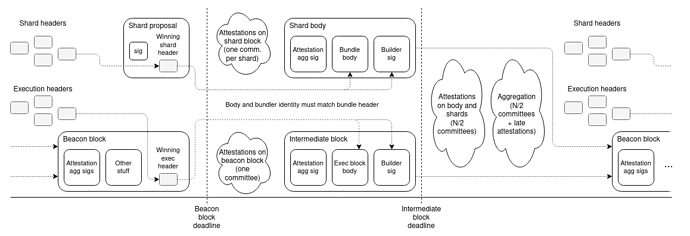See previous ideas on this topic: Proposer/block builder separation-friendly fee market designs
Sequence of events in a slot pair
- Right before 0 seconds - exec header publishing: anyone can publish an exec header, which contains an exec block hash, a bid, and a signature from the builder
- 0 seconds - beacon block deadline: beacon block must include the winning exec header
- 0-2.67 seconds - attestations on beacon block: only one committee attests to the beacon block
- 8 seconds - intermediate block deadline: the winning builder publishes an intermediate block, consisting of the exec block body and as many attestations on the beacon block as they can find
- 8-10.67 seconds - attestations on intermediate block: the remaining N-1 committees attest to the intermediate block
- 10.67-13.33 seconds - aggreation of intermediate block attestations
- 13.33-16 seconds - next exec header publishing
If a beacon block is missing, the next slot is switched to be for a beacon block instead of an intermediate block.
In diagram form
Key intuitive properties
- From a fork choice perspective, the system can be described as a beacon chain just like the current one, except with uneven committee sizes and with a (block, slot) fork choice. The only difference is that some of the blocks are only there to select proposers for the block right after them. This simplifies analysis.
- A committee in between each step helps to ensure that each step is “safe” and reduces vulnerability to abuses by single actors
Safety properties for builders
At the bid publishing step, builders see the head, and know whether it’s safe or unsafe (a head could be unsafe if there are lots of disagreeing or missing attestations).
- If a head is safe, the head cannot be reverted barring a 45%+ attack, significant amounts of slashing, or extreme network latency. In this case, builders can feel confident bidding safely.
- If the head is unsafe, there is a risk that the chain could be reorged after they release their body, “stealing” their MEV opportunities. In this case, builders see this risk and can decrease their bids to claim a risk premium for this risk.
At time of intermediate block publishing, there are two cases:
- The beacon block has not been published. In this case, the attestation committee will have voted against the block, and so the intermediate block producer (aka. the builder) can safely not publish, and will not be penalized.
- The beacon block has been published. In this case, the intermediate block has a “proposer boost” slightly greater in size than the entire attestation committee, so if the builder publishes, their block will win in the eyes of the remaining N-1 attestation committees.
This ensures that if the attestation committees are honest, and latency is not extremely high, the builder is guaranteed to:
- Get included if they publish
- Not be penalized if they do not publish because the beacon block header is missing
The builder has a period of ~5.33-8 seconds during which to publish. They can safely publish as soon as they see the beacon block; however, they may want to wait until they see more attestations, as they get rewarded for including attestations (attesters that get included also get a reward themselves). They are free to negotiate the tradeoff between (5.33 second window, get attestation inclusion reward) and (8 second window, get no attestation inclusion reward) as they wish.
Beacon chain spec change sketch
Proposer index definition
- Set
get_random_proposer_index(state: State)to whatget_beacon_proposer_index(state)returns today. - Add state variables
chosen_builder_indexandchosen_exec_block_hash. If a slot is empty, setstate.chosen_builder_index = NO_BUILDER(a constant equal to2**64 - 1). If a slot contains a beacon block which contains aBuilderBid, set:state.chosen_builder_index = builder_bid.message.builder_indexstate.chosen_exec_block_hash = builder_bid.message.exec_block_hash
- Define
get_beacon_proposer_index(state: State)as follows:- If
state.chosen_builder_index == NO_BUILDER, returnget_random_proposer_index(state) - Otherwise, return
state.chosen_builder_index
- If
Conditions on bid-carrying block
- If
state.chosen_builder_index == NO_BUILDER, the block is required to contain aBuilderBidand may not contain anExecBody. Thebuilder_bidis required to pass the following checks, whereval = state.validators[builder_bid.message.builder_index]:bls.Verify(val.pubkey, compute_signing_root(builder_bid.message), builder_bid.signature)val.activation_epoch == FAR_FUTURE_EPOCH or val.withdrawable_epoch <= get_current_epoch(state)val.balance >= builder_bid.bid_amount
- Add a balance transfer to the processing logic:
val.balance -= builder_bid.bid_amountstate.validators[get_beacon_proposer_index(state)].balance += builder_bid.bid_amount
- Change
get_committee_count_per_slotto take inputs(state: BeaconState, slot: Slot)(instead of epoch). If a slot hasstate.chosen_builder_index == NO_BUILDER, the committee count should return 1.
Conditions on exec-body-carrying block
- If
state.chosen_builder_index != NO_BUILDER, the block is required to contain anExecBodyand may not contain aBuilderBid. Theexec_bodyis required to pass the following checks:hash_tree_root(exec_body) == state.chosen_exec_block_hasheth1_validate(exec_body, pre_state=state.latest_exec_state_root)
- Add to the processing logic:
state.latest_exec_state_root = exec_body.post_state_root
- The
get_committee_count_per_slotshould return(get_epoch_committee_count(epoch) - state.committees_in_this_epoch_so_far) // (slots_remaining_in_epoch) - If
state.chosen_builder_index != NO_BUILDER, setstate.chosen_builder_index = NO_BUILDER, regardless of whether or not there is a block.
Notes
- Reduce slot time to 8 seconds (remember: 1 exec block will come every 2 slots)
- All beacon blocks, including bid-carrying and exec-carrying, should get a proposer boost in the fork choice.
- Fork slot should be changed to (block, slot).
Possible extension: delayed publishing time with a fee
If the intermediate block builder does not publish during slot N, no bundle is selected in slot N+1. The entire proposer sequence gets pushed back by one slot (so the slot N+1 proposer becomes the slot N+2 proposer, etc), and a new random proposer is chosen for slot N+1. The builder gets another chance (so, an extra 12 seconds of slack) to publish. The slot N+1 exec block cannot contain any high-value consensus transactions (ie. slashings). However, they get penalized block.basefee * block.target_gas_limit.
The intuition is that they are delaying their exec block by one slot and prepending it with an empty exec block, so they need to pay for that slot. The proposer sequence being delayed ensures that delaying one’s exec block is not useful for stealing future proposal rights in times when they are high-value.

